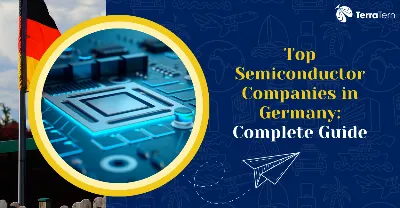Key Highlights
- What are the Top Semiconductor Companies in Germany in 2025?
- What Are the Leading Semiconductor Companies in Germany?
- Where Are Semiconductor Manufacturing Facilities Located in Germany? Latest Update 2025
- What Types of Semiconductors Do German Companies Produce in 2025?
- Why Is Germany Important for the Global Semiconductor Industry? Experts Insights 2025
- How Do German Semiconductor Companies Compare Globally?
- What Challenges Do German Semiconductor Companies Face in 2025?
- How to Partner with German Semiconductor Companies?
- What Is the Future Outlook for German Semiconductor Companies?
- How TerraTern Can Help
- Conclusion
By 2025, Germany's chip ecosystem will be growing rapidly through contributions of global leaders as well as by specialised suppliers in the middle-class enterprises (Mittelstand) in the fields of design, material, equipment and fabs. This is a complete guide focused on semiconductor companies in Germany, from fabless innovators to wafer makers. It also reports the best semiconductor manufacturing companies in Germany.
Those which are based in, or have invested in, key locations such as Saxony, Bavaria, and Berlin are given priority. Expect the short profiles along with the strengths, core technologies, footprint of your company and information about talent pipelines, supply chain, and government-backed growth.
What are the Top Semiconductor Companies in Germany in 2025?

Semiconductor companies in Germany are as follows:
-
Market Leadership: The global semiconductor companies of Germany will also witness a revenue of EUR16.87 billion in the year 2025, and this will become EUR22.10 billion revenue by the year 2030 with a CAGR of 5.60%.
-
Top Players: Infineon Technologies AG has a leading market share of 29% in the Automotive_Microcontrollers market globally, and the players Robert Bosch GmbH Semiconductor Division, GlobalFoundries Dresden, X-FAB Silicon Foundries SE, and Elmos Semiconductor SE
-
Silicon Saxony Cluster: The cluster has more than 70 ecosystem companies, which together produce a third of all chips manufactured in Europe, with top-class production located at Bosch, GlobalFoundries and Infineon.
-
Major Fabrication Hubs: One of the four semiconductor companies is headquartered in Germany with its fabs in Dresden, Moscow, Regensburg and Hamburg: Power electronics and automotive chips are the primary focus.
-
Core Business: Automotive semiconductors (No. 1 in the world) of Infineon, SiC/GaN power electronics, MEMS sensor solutions for Industry 4.0 and integrated circuits (86.2% market share).
-
EU Market Position: Germany aims to produce 20% of Europe's semiconductors in 2030 with the EU Chips Act and a EUR50 billion government investment.
-
Recent Expansions: Infineon contract EUR5 billion Smart Power Fab Dresden (being held in 2026); TSMC opens the third international plant in Dresden
-
Employment & Innovation: More than 75,000 professionals in the areas of design, fabrication and R&D; dual education programs to tackle skilled labour shortage. Specialisation
-
Third Party Seal: IP-rich portfolios of design/fabless vendors, which hold 67.8% market share for automotive and industrial customers, for accelerated time to market for application-specific ICs
-
Global Integration: German-based Semiconductor companies utilise their closeness to automotive OEMs (BMW, Mercedes-Benz, Volkswagen) to enhance the speed, quality, and time-to-market in automotive chip development.
Also Read: Automotive Companies in Australia: Evolution and Future Trends
What Are the Leading Semiconductor Companies in Germany?
Germany’s leaders among semiconductor companies in Germany include Infineon Technologies, Bosch Semiconductors, ams OSRAM (OSRAM Opto Semiconductors), GlobalFoundries Dresden, X-FAB, NXP Germany, Elmos, and equipment providers like Aixtron, spanning automotive, power, MEMS, and optoelectronics across hubs in Dresden, Munich, and Regensburg.
Latest List of Top Semiconductor Companies in Germany in 2025
|
Name |
HQ Location |
Revenue 2024 |
Employees |
Specialty |
Founding Year |
Ownership |
|
Infineon Technologies |
Munich |
Refer to the FY2024 annual report |
Global workforce |
Automotive/power/security ICs |
1999 |
German public company |
|
Bosch Semiconductors |
Reutlingen |
Within the Bosch Group reporting |
Within the Bosch Group |
Automotive sensors/MEMS/power |
1886 (Group) |
German private group division |
|
ams OSRAM (OSRAM Opto) |
Regensburg |
Group consolidated reporting |
Group consolidated |
Optoelectronics: LED/IR/laser |
1978/2020 (group tie-up) |
Austrian-listed group with German ops |
|
GlobalFoundries Dresden |
Dresden |
Company consolidated reporting |
Company consolidated |
Speciality foundry (automotive/industrial) |
2009 (GF) |
U.S.-listed with German fab |
|
X-FAB |
Dresden/Erfurt ops |
Company consolidated reporting |
Company consolidated |
Analogue/MEMS foundry |
1992 |
Public, multinational operations |
|
NXP Germany |
Hamburg/Munich |
Group consolidated reporting |
Group consolidated |
Automotive MCUs/radar/secure ICs |
2006 (NXP) |
Dutch-listed with German ops |
|
Elmos Semiconductor |
Dortmund |
Company reporting |
Company reporting |
Automotive mixed-signal ICs |
1984 |
German public company |
|
Aixtron |
Herzogenrath (Aachen) |
Company reporting |
Company reporting |
MOCVD equipment for compound semis |
1983 |
German public company |
|
OSRAM Opto Semiconductors |
Regensburg |
Included above |
Included above |
Optoelectronics for auto/industrial |
1999 (subsidiary) |
German subsidiary within ams OSRAM |
|
Micronas (TDK-Micronas Germany) |
Freiburg |
Group reporting |
Group reporting |
Automotive Hall sensors/ICs |
1990 (Micronas AG legacy) |
Japanese parent with German ops |
|
Rohde & Schwarz (Semiconductor units) |
Munich |
Group reporting |
Group reporting |
RF components/test ecosystem |
1933 |
German private group |
|
Siltronic |
Munich/Burghausen |
Company reporting |
Company reporting |
Silicon wafers |
1994 |
German public company |
|
Wacker Chemie (Silicon materials) |
Munich/Burghausen |
Group reporting |
Group reporting |
Polysilicon/materials |
1914 |
German public company |
|
First Sensor (TE Connectivity) |
Berlin |
Group reporting |
Group reporting |
Sensors for industrial/auto |
1991 |
U.S. parent with German ops |
|
LFoundry (historic German links) |
— (Italy base) |
Group reporting |
Group reporting |
CMOS image sensor foundry |
2006 |
Foreign ownership; EU footprint |
Infineon Technologies – Germany's Semiconductor Giant
Infineon Technologies, Germany's semiconductor giant, is as follows:
-
Infineon Technologies Germany leads in automotive semiconductors and power management, with major German sites in Dresden, Regensburg, and Munich supporting global programs in auto, industrial, and security.
-
Key strengths include traction in Si/SiC power devices, automotive microcontrollers, and security ICs for payments and ID, underpinned by continuous capacity investments in Dresden.
Product focus:
-
Automotive MCUs and power modules for electrification and ADAS.
-
Industrial drives, renewables inverters, and power management ICs.
-
Security controllers for payments, eID, and embedded security.
Bosch Semiconductors – Automotive Innovation Leader
Bosch Semiconductors' automotive innovation leaders are as follows:
-
Bosch’s semiconductor division in Reutlingen produces MEMS sensors, automotive sensors, and power devices, benefiting from tight coupling with Bosch’s automotive systems engineering.
-
This vertical integration accelerates requirements capture and validation in vehicles, sharpening time-to-market for safety-critical designs.
Key products:
-
MEMS accelerometers, gyros, pressure and environmental sensors for cars.
-
Power semiconductors for powertrain and domain controllers.
-
Specialised ASICs for automotive systems
OSRAM Opto Semiconductors – Lighting & Sensor Technology
OSRAM opto semiconductors, lighting & sensor technology are as follows:
-
Ams OSRAM’s Regensburg operations specialise in LEDs, infrared components, and laser diodes for automotive lighting, driver monitoring, and industrial sensing.
-
The pivot to auto/sensing applications aligns with growth in LiDAR, driver attention monitoring, and high-efficiency lighting.
Other Major German Semiconductor Players
Other major German semiconductor players are as follows:
-
GlobalFoundries Dresden supplies speciality foundry capacity for automotive and industrial nodes, embedded NVM, MEMS, and RF.
-
X-FAB focuses on analogue/mixed-signal and MEMS foundry services with strong automotive quality systems.
-
Elmos delivers automotive mixed-signal ICs for body, sensor, and power subsystems, serving European OEMs and Tier-1s.
-
NXP Germany anchors automotive radar, MCUs, and secure connectivity within a global platform, integrated into German OEM programs.
-
Aixtron supplies critical MOCVD equipment enabling compound semiconductor and LED production for European and global fabs.
Where Are Semiconductor Manufacturing Facilities Located in Germany? Latest Update 2025

Semiconductor manufacturing facilities located in Germany are as follows:
|
Location |
Companies |
Fab Type |
Capacity |
Specialization |
|
Dresden, Saxony |
GlobalFoundries; Bosch; Infineon; TSMC/ESMC JV |
300mm logic/speciality and power; FinFET/FD-SOI |
GF Fab 1 up to 80,000 300mm wpm (max); ESMC planned 40,000 300mm wpm by 2027 |
Automotive/industrial logic, FDSOI/FinFET, power semiconductors |
|
Regensburg, Bavaria |
Infineon Regensburg; ams OSRAM (OSRAM Opto) |
Front-end + back-end (power) and optoelectronics |
Not disclosed |
Power semiconductors; LEDs/IR/laser diodes for automotive/industrial |
|
Hamburg |
Nexperia; NXP Germany |
200mm power (GaN/SiC) at Nexperia; R&D/Test at NXP |
Not disclosed |
Power devices (GaN/SiC), RF/mixed-signal, automotive radar and secure MCU ecosystem |
|
Reutlingen, Baden-Württemberg |
Bosch Semiconductors |
150/200mm MEMS and automotive sensors; SiC power |
Not disclosed |
MEMS sensors, automotive ASICs, SiC power for e-mobility |
|
Dresden cluster context |
Silicon Saxony association and ecosystem |
Clustered fabs, equipment, materials, R&D |
Cluster scale, not a single fab metric |
Europe’s densest microelectronics cluster with 600+ members supporting manufacturing |
Dresden – Germany's Silicon Saxony Hub
Dresden is Germany’s Silicon Saxony hub, as follows
-
Cluster overview and History: Transformed from GDR microelectronics into Western Europe’s leading 300mm cluster under the Silicon Saxony association, now counting hundreds of member organisations across the whole value chain.
-
Major Companies and Facilities: GlobalFoundries Fab 1 (300mm), Bosch’s 300mm fab in Dresden, Infineon’s Smart Power Fab build-out, and the ESMC JV (TSMC 70% with Bosch/Infineon/NXP) bringing 28/22nm and 16/12nm capacity to Europe.
-
Production Capabilities and Technologies: 300mm speciality and automotive-qualified nodes (e.g., FDSOI, embedded NVM) at GlobalFoundries, advanced power (SiC/IGBT) at Infineon’s new fab, and FinFET via ESMC for automotive and industrial logic.
-
Research Institutions: Fraunhofer IPMS/CNT and TU Dresden anchor applied R&D and talent pipelines, complemented by regional Helmholtz and Leibniz institutes integrated with local fabs and design centres.
-
Supplier Ecosystem: Engineering and equipment providers such as Exyte are scaling local footprints to support fab construction, ramp, and lifecycle upgrades across Dresden semiconductor companies.
-
Workforce and Talent: A five-figure semiconductor workforce, supported by dual-education programs and university collaboration, enables rapid scaling and high automotive-grade yield standards.
Bavaria – Munich and Regensburg Corridor
Bavaria, Munich and Regensburg Corridor are as follows:
-
Regional Overview: Munich and Regensburg host Infineon’s headquarters and Regensburg fab, as well as ams OSRAM’s Regensburg operations, creating a power-and-opto anchor for semiconductor companies in Germany serving automotive and industrial markets.
-
Infineon Facilities: Munich leads corporate and R&D activities, while Regensburg handles power semiconductor manufacturing and the backend for modules aligned with EVs, renewables, and industrial drives.
-
OSRAM Regensburg: Ams OSRAM specialises in LEDs, infrared emitters, and laser diodes for automotive lighting and sensing, which are core capabilities in Bavarian semiconductor optoelectronics.
-
Automotive Links: Proximity to BMW, Audi, and Tier-1 suppliers forms a closed-loop collaboration that accelerates chip specification, validation, and series production for automotive programs.
-
University Partnerships: TSMC and the Technical University of Munich launched the MACHT-AI initiative in Bavaria to deepen chip design and AI R&D ties with the regional industry.
-
Policy and Talent: Bavaria’s initiatives, including the Bavarian Chip-Design-Centre, strengthen design capacity, skills pipelines, and supplier integration across Munich–Regensburg semiconductor manufacturing.
Emerging Locations and Expansion Plans
Emerging locations and expansion plans are as follows:
-
TSMC/ESMC Dresden: A €10+ billion JV with Bosch, Infineon, and NXP targets 28/22nm and 16/12nm nodes with ~40,000 wafers/month capacity and production starting in 2027.
-
Infineon Dresden Expansion: The €5 billion Smart Power Fab received final funding in May 2025, with operations slated to begin in 2026 to scale automotive- and industrial-focused power semiconductor output.
-
Intel Magdeburg Status: The previously announced €30 billion leading-edge fab was officially cancelled in July 2025 amid strategic shifts, leaving speciality/power as Germany’s near-term manufacturing focus.
-
Subsidy Framework: EU Chips Act–aligned federal and state programs in Saxony and Bavaria co-fund strategic fabs, workforce training, and infrastructure to anchor supply chains locally.
-
Economic Impact: These projects add tens of thousands of wafers/month of capacity and create thousands of high-tech jobs across construction, fab operations, and supplier networks, reinforcing Europe’s auto/industrial chip resilience.
-
Strategic Insight: Germany’s expansion prioritises speciality nodes and power semiconductors over sub-5nm logic, balancing sovereignty goals with existing strengths in automotive-grade semiconductor manufacturing.
Also Read: Top Engineering Companies in Australia: Latest List
What Types of Semiconductors Do German Companies Produce in 2025?
The types of semiconductors that German companies produce are as follows:
-
Key Product Families: Automotive microcontrollers and domain/power ICs, power semiconductors (IGBTs, MOSFETs, SiC, GaN), optoelectronics (LED/IR/laser), sensors and MEMS, and industrial analogue/mixed-signal ICs supporting drives, factory automation, and energy systems.
-
Technology Nodes: Emphasis on mature, automotive-qualified processes around 28 nm–180 nm and speciality platforms (FDSOI, embedded NVM, Si/SiC/GaN power) rather than cutting-edge logic nodes, reinforced by Dresden and Bavaria clusters.
-
Applications Mix: Automotive and industrial dominate by value, while consumer and communications are addressed through speciality RF, MEMS, security, and optoelectronic components from leading German device makers and foundries.
-
Ecosystem Drivers: Including proximity to OEMs/Tier-1s, university–institute networks, and EU-Chips-Act incentives, enable high-reliability output and rapid qualification cycles across IDMs, fabless, and foundries in Germany.
-
Outlook: Expanding SiC/GaN capacity and new Dresden foundry investments will lift local speciality logic and power supply, deepening Germany’s role in automotive, energy, and industrial semiconductor supply chains through 2030.
Automotive Semiconductors – Germany's Competitive Advantage
Automotive semiconductors in Germany's competitive advantage are as follows:
-
Market Position: German champions hold leadership in automotive microcontrollers, powertrain electronics, and security ICs, with Infineon a top global supplier and a core pillar of the national semiconductor base.
-
Product Scope: MCUs, power management, radar/ultrasonic sensors, battery management ICs, and domain/zone controllers anchor EV and ADAS platforms led by German OEM ecosystems.
-
OEM Integration: Tight co-development with BMW/Audi and Tier-1s in the Munich–Regensburg corridor accelerates specification, validation, and series production for automotive programs.
-
Cluster Advantage: Dresden’s 300 mm capacity and Munich/Regensburg design–manufacturing loop shorten feedback cycles and reinforce A-grade quality for safety-critical deployments.
-
Direction: Added Dresden capacity (ESMC foundry plus Infineon Smart Power Fab) will localise more logic and power content for next-gen EV and ADAS architectures.
Power Semiconductors and Energy Management
Power semiconductors and energy management are as follows
-
Scope: Germany leads in European power semiconductors—IGBTs, MOSFETs, SiC, and GaN—for EV inverters/chargers, renewable-energy inverters, data-centre PSUs, and industrial drives in semiconductor.
-
Leadership: Infineon’s global share in automotive MCUs and power, plus sustained CAPEX in Dresden, underpins domestic capacity for EV and energy transition demand.
-
Materials Shift: SiC and GaN ramp on 300 mm-capable lines, with Germany progressing toward higher efficiency and volume scale in 300 mm GaN milestones.
-
Applications Pull: electrification and renewables in Europe drive sustained demand for robust, high-efficiency power devices produced on mature, automotive-qualified nodes.
-
Outlook: EU-Chips-Act funding and power-focused fab expansions will raise local share in EV/energy infrastructure semiconductors through the late 2020s.
Sensors, MEMS, and optoelectronics
Sensors, MEMS, and optoelectronics are as follows.
-
MEMS Strength: German suppliers are global leaders in automotive-grade MEMS (pressure, inertial, environmental) and mixed-signal sensor ICs, integrating them across vehicle platforms in the semiconductor industry.
-
Optoelectronics: ams OSRAM’s Regensburg base anchors LEDs, IR emitters, and laser diodes for headlights, driver monitoring, and machine vision across auto/industrial markets.
-
System Integration: close coupling of sensors, optics, and power/MCUs enables reliable modules for ADAS, cabin monitoring, and factory automation within regional clusters.
-
Future use cases, such as LiDAR, high-brightness LEDs, and IR sensing, will expand with autonomous features and smart factories, supported by Bavaria and Saxony R&D networks.
Why Is Germany Important for the Global Semiconductor Industry? Experts Insights 2025

Germany is pivotal to the global chip ecosystem because semiconductor companies dominate automotive, power, and sensor niches that are critical to EVs, industrial automation, and safety systems, even as overall wafer volumes remain smaller than Asia’s leading hubs.
-
Strategic Role: Germany’s chip strengths are concentrated in automotive ICs, power semiconductors, MEMS, and optoelectronics—application areas with high reliability requirements and tight OEM integration that create outsized global influence for semiconductor companies in Germany.
-
Ecosystem Depth: A complete value chain spans IDMs, foundries, equipment, materials, and R&D institutes, with Dresden’s “Silicon Saxony” and the Munich–Regensburg corridor acting as Europe’s most mature manufacturing clusters for semiconductor manufacturing companies in Germany.
-
Market Segments: Domestic production is skewed toward automotive and industrial end-markets, with mature/speciality nodes and power materials (SiC/GaN) prioritised over cutting-edge mobile logic.
-
Equipment and Materials: Germany hosts critical materials and equipment capabilities alongside device makers, reinforcing local ramp-ups and qualification for high-reliability applications.
-
Policy Leadership: National subsidies aligned with the EU Chips Act have unlocked multi-billion-euro fab projects in Dresden, strengthening regional capacity and European sovereignty goals.
-
R&D and Innovation: Fraunhofer, TU Munich, and TU Dresden channel applied research into manufacturable processes and packages, accelerating technology transfer for automotive-grade devices.
-
Workforce Advantage: Dual-education pipelines and dense supplier networks shorten time-to-qualification for safety-critical chips, a key differentiator for semiconductor companies in Germany.
-
Economic Impact: Announced expansions add tens of thousands of wafers per month and thousands of high-tech jobs, reinforcing Europe’s EV, renewable, and industrial supply chains.
Automotive Industry Integration and Innovation
Automotive industry integration and innovation are as follows.
-
Proximity Benefits: Co-location with BMW, Audi, and Tier-1s enables on-site co-development that speeds specification, validation, and series launch cycles for automotive semiconductors.
-
Joint Programs: The Munich–Regensburg collaboration links chip architects, power engineers, and system integrators, improving module reliability and compliance for safety-critical features.
-
Faster Iteration: Cluster density in Dresden and Bavaria compresses feedback between design, fab, and OEM qualification, reducing change-cycle latency versus dispersed supply chains.
-
Quality Leadership: Automotive-grade standards benefit from Germany’s mature test, packaging, and metrology ecosystems tied to local fabs and research institutes.
-
Resilience: Regional sourcing and policy support reduce exposure to cross-border disruptions for key automotive electronics platforms.
-
Example Pathways: New Dresden capacity and Bavarian design hubs channel more EV, ADAS, and power content into local production programs for semiconductor companies in Germany.
-
Competitive Moat: The OEM–semiconductor co-engineering model sustains premium pricing and sticky platform wins, especially in EV power and ADAS domains.
European Semiconductor Sovereignty Leadership
European semiconductor sovereignty leadership are as follows.
-
EU Chips Act Anchor: Germany hosts a large share of EU-backed capacity additions, including the ESMC (TSMC-led) Dresden fab and Infineon’s Smart Power Fab, aligning sovereignty with industrial strengths.
-
National Subsidies: Federal/state support in Saxony and Bavaria accelerates permitting, training, and infrastructure for strategic projects by semiconductor manufacturing companies in Germany.
-
Capacity Pipeline: ESMC targets ~40k wpm by 2027 while Infineon’s Dresden expansion scales power output from 2026, materially lifting Europe’s speciality capacity.
-
Policy Influence: Germany’s cluster associations and agencies coordinate investments, workforce programs, and supplier localisation across Dresden, Munich, and Regensburg.
-
Benefits to Firms: Subsidies and ecosystem services lower ramp risk for IDMs and foundries, supporting more regional sourcing for European OEMs.
-
Challenges: Leading-edge logic remains abroad; Germany’s pragmatic focus is on speciality nodes, power, and automotive logic, where it can lead globally.
-
Strategic Insight: By doubling down on “More-than-Moore,” Germany strengthens Europe’s autonomy in EVs, energy, and industrial systems, even without sub-5nm logic domestic capacity for now.
Also Read: Top 10 Electrical Companies in the World: Latest Guide
How Do German Semiconductor Companies Compare Globally?
Germany’s position is defined by category leadership (automotive, power, sensors/opto) rather than volume, with strengths concentrated in IDMs and speciality foundries serving automotive and industrial markets.
|
Metric |
Germany |
United States |
Taiwan |
European Context |
|
Aggregate position |
Top-10 by company revenues with speciality leadership in auto/power |
Global leader by revenue scale and leading-edge logic |
Leading foundry hub with advanced nodes |
Germany anchors EU manufacturing clusters and investments |
|
Core strengths |
Automotive ICs, power devices, MEMS, optoelectronics |
CPUs/GPUs/AI accelerators, broad analogue/mixed-signal |
Advanced logic/foundry services |
Speciality nodes and automotive focus via Dresden/Bavaria |
|
Node focus |
Mature speciality nodes (≈28–180 nm) plus SiC/GaN |
Cutting-edge logic and broad nodes |
Cutting-edge logic (sub-7 nm) |
Expansion in speciality/power capacity 2026–2028 |
Infineon vs. Global Semiconductor Leaders
Infineon is a top-tier automotive and power leader with strong Munich–Regensburg and Dresden footprints, competing against diversified peers by focusing on auto, power, industrial, and security ICs.
|
Company |
Focus Segments |
Segment Leadership |
Notable Strengths |
Notable Constraints |
|
Infineon (Germany) |
Automotive MCUs, power (IGBT/MOSFET/SiC/GaN), security ICs |
Leadership in automotive and power categories across EU programs |
Deep OEM integration; EU-funded Dresden capacity; security & power breadth |
Limited exposure to sub-7 nm AI logic; relies on speciality nodes |
|
Texas Instruments |
Broadanalogueg/mixed-signal, power management |
Scale and breadth across analogue markets |
Manufacturing discipline and margins in analogue |
Less auto-centric integration than German clusters |
|
NXP |
Automotive MCUs, radar, secure connectivity; strong Germany footprint |
Automotive radar/MCUs leadership |
Secure automotive comms and embedded processing |
Foundry dependence for leading nodes |
|
STMicroelectronics |
Automotive, power, and sensors across the EU footprint |
Power and auto platform depth |
Broad mixed-signal and power portfolio in the EU |
Competes head-to-head with Infineon in the EU auto/power |
|
Renesas |
Automotive MCUs, power, and industrial control |
Strong auto MCU share |
Embedded control depth across auto/industrial |
Less EU cluster integration vs. Germany |
Germany’s Position in Emerging Technologies
German players are doubling down on SiC and GaN power, advanced packaging for automotive/industrial reliability, and speciality logic through Dresden expansions, while partnering for leading-edge AI logic abroad.
|
Technology |
Germany’s Position |
Representative Firms/Programs |
Key Risks |
|
SiC power |
Scaling capacity and devices for EV/renewables; leadership trajectory in Europe |
Infineon Smart Power Fab Dresden; auto/energy customers |
Global materials supply and ramp yield |
|
GaN power (300 mm) |
Demonstrated 300 mm milestones; moving toward higher-volume platforms |
Infineon 300 mm GaN roadmap and sample milestones |
Maturity and cost vs. SiC in high-power use cases |
|
Speciality logic (28–12'nm) |
ESMC Dresden adds EU’s first FinFET pure-play foundry capacity |
TSMC-led JV with Bosch/Infineon/NXP in Dresden |
Ramp timelines and ecosystem staffing |
|
Leading-edge logic (<7'nm) |
Limited local capacity; reliance on external foundries |
Partnerships and design centres in Bavaria |
Strategic dependence on the U.S./Asia supply |
|
Sensors/MEMS/opto |
Strong auto/industrial MEMS and automotive LED/IR/laser |
Bosch MEMS; ams OSRAM Regensburg |
Competition from Asia in consumer volumes |
What Challenges Do German Semiconductor Companies Face in 2025?

German chip makers operate under five critical constraints that shape strategic choices and investment priorities for maintaining global positions in automotive, power, and industrial semiconductors.
|
Challenge Category |
Impact Severity |
Key Metrics |
Mitigation Approaches |
|
Production cost disadvantage |
High |
30–40% higher vs. Asia; labour ~€65k avg. vs. $35k Asia |
Automation, speciality/high-margin focus, EU subsidies |
|
Talent shortage |
High |
~15k unfilled roles projected by 2027; aging workforce (avg. age 47) |
International recruitment, dual-education, university tie-ups |
|
Automotive concentration |
Medium-High |
~62% revenue from auto vs. 35% global; cyclical exposure |
Industrial/IoT diversification; EV/ADAS content growth |
|
Node/process limitations |
Medium |
Primarily 28–180 nm; limited sub-20 nm domestic capacity |
ESMC JV for FinFET; focus "More-than-Moore" |
|
Geopolitical/supply-chain risk |
High |
75% advanced logic from Taiwan; 40% packaging from China |
Reshoring (Dresden expansions), dual sourcing, strategic inventory |
Production Cost Disadvantages vs. Asian Competition
Production cost disadvantages vs. asian competition are as follows:
-
Labour Cost Gap: German semiconductor engineers average ~€65,000 compared to ~$35,000 in Asia (Taiwan/China), which raises direct labour and overhead costs for semiconductor manufacturing companies
-
Energy Premium: Industrial electricity in Germany is ~€0.28/kWh compared to ~€0.09/kWh in China, materially increasing fab operating expenses and carbon footprint.
-
Regulatory Burden: Environmental compliance, permitting timelines, and safety standards add cost and cycle time relative to Asian jurisdictions.
-
Automation Offset: German fabs achieve higher throughput per worker via automation, closing ~40–50% of the productivity gap but still leaving a net cost penalty.
-
Speciality Focus: Cost structures compel prioritisation of high-margin automotive, power, and MEMS over volume commodity logic for semiconductor companies in Germany.
-
Subsidy Impact: EU Chips Act and national programs reduce effective CAPEX by ~20–30%, narrowing cost disadvantages for strategic fabs.
-
Strategic Response: Concentration on applications where reliability, co-development speed, and qualification matter more than per-unit cost for semiconductor manufacturing companies.
Talent Shortage and Skills Gap
Talent shortage and skills gap are as follows.
-
Vacancy Scale: Current ~8,400 unfilled semiconductor roles in Germany projected to reach ~15,000 by 2027 amid fab expansions and retirements.
-
Enrollment Decline: Electrical engineering enrollment is down ~18% since 2015, constricting the domestic talent pipeline for semiconductor companies in Germany.
-
Ageing Workforce: Industry average age ~47 compared to national ~42; a wave of retirements threatens knowledge transfer and staffing continuity.
-
International Competition: Tech firms (Google, Amazon) and automotive digital units compete for the same embedded/chip talent pool, raising salaries.
-
Foreign Recruitment: ~45% of new hires now come from abroad (vs. ~22% in 2015), creating integration and language challenges for local teams.
-
Dual-Education Expansion: Silicon Saxony, universities, and companies scale apprenticeship and coop programs to grow skilled technicians and engineers.
-
University Tie-Ups: TSMC–TUM AI centre and Fraunhofer partnerships aim to deepen applied R&D and train next-gen specialists in Bavaria and Saxony.
Automotive Market Concentration Risk
Automotive market concentration risks are as follows:
-
Revenue Skew: ~62% of German semiconductor revenue from automotive vs. ~35% global average, amplifying cyclical exposure for semiconductor companies in Germany.
-
Recent Volatility: 2023 inventory corrections drove a ~8.3% decline in domestic revenue, even as the global market grew by ~1.2%, illustrating cycle sensitivity.
-
EV Transition Impact: Shift to battery-electric powertrains changes chip mix (more power devices, fewer engine-management ICs), requiring portfolio pivots.
-
Customer Concentration: Major revenue from a handful of German OEMs (BMW, Mercedes, VW/Audi) introduces negotiation and forecasting risks for semiconductor manufacturing companies in Germany.
-
Diversification Efforts: Expanding industrial (factory automation, robotics) and IoT/consumer segments to reduce auto dependency, though progress is gradual.
-
Long-term TAM Concern: Automotive's share of total semiconductor TAM declining (~20% in 2025 → projected ~15% by 2030) as AI/data-centre chips grow faster.
Technology Node and Process Limitations
Technology node and process limitations are as follows:
-
Current Capabilities: Dresden and Bavaria fabs operate primarily at 28–180 nm mature/speciality nodes, with limited sub-20 nm domestic capacity for semiconductor companies in Germany.
-
ESMC Upgrade: TSMC-led JV brings 28/22 nm planar and 16/12 nm FinFET to Dresden by 2027, narrowing but not closing the leading-edge gap.
-
Advanced Logic Dependence: German firms rely on TSMC/Samsung for sub-7 nm logic in AI accelerators, mobile, and high-performance compute.
-
Economic Reality: Building competitive 3 nm capacity requires $20+ billion and a multi-year ramp against entrenched Asian leaders with decade-long head-starts.
-
Strategic Rationale: "More-than-Moore" focus on SiC/GaN power, analogue precision, and MEMS leverages Germany's engineering depth and automotive access without chasing unwinnable transistor-density races for semiconductor manufacturing companies in Germany.
-
Chiplet/Packaging Alternative: Advanced heterogeneous integration (2.5D/3D packaging) can combine German speciality dies with Asian logic, mitigating node gaps.
Geopolitical and Supply Chain Vulnerabilities
Geopolitical and Supply Chain Vulnerabilities are as follows.
-
Taiwan Dependence: ~75% of advanced logic consumed by German systems sourced from Taiwan foundries, a single-point geopolitical risk.
-
China Packaging Exposure: ~40% of assembly/test services for European semiconductors are performed in China, vulnerable to trade or security disruptions.
-
Materials Concentration: ~65% of photoresists and speciality chemicals from Japan; silicon wafers are concentrated in Japan and Taiwan supply bases.
-
2021 Shortage Impact: Automotive chip shortages cost German OEMs more than €27 billion in lost production, exposing the fragility of just-in-time, Asia-centric supply chains.
-
Reshoring Response: €20+ billion in Dresden fab investments (ESMC, Infineon) aim to localise speciality capacity by 2027–2028, reducing but not eliminating reliance on Asia for semiconductor companies in Germany.
-
Dual-Sourcing and Inventory: Companies build strategic buffers and qualify multiple suppliers for critical components, raising working-capital needs.
-
EU Policy Alignment: The Chips Act and supply-chain resilience programs coordinate member-state efforts to diversify sourcing and strengthen regional capabilities for semiconductor manufacturing companies in Germany.
Also Read: Top 10 Construction Companies in Germany: Latest List
How to Partner with German Semiconductor Companies?
Expect multi-phase, co-engineered engagements, stringent quality gates, and multi-year commitments with program-level volume plans rather than transactional spot buys, especially in automotive and power segments served by Dresden and Munich–Regensburg hubs.
Partners with German semiconductor companies are as follows.
-
Fit Assessment: Best-fit partners seek speciality devices (power, MEMS, optoelectronics, automotive MCUs) on mature nodes with high reliability requirements and integrated application support.
-
Timelines: Design-in and qualification cycles typically span multiple quarters due to safety, compliance, and OEM validation steps coordinated through local institutes and cluster networks.
-
Access Path: Begin with technical discovery alongside application engineers, align with program roadmaps, and leverage cluster resources (Fraunhofer, universities) for rapid prototyping and validation.
Technical Qualification and Co-Development Process
Technical qualification and co-development process are as follows:
-
Stage Flow: NDA and requirements capture → schematic/layout reviews → sample builds → application notes and safety analysis → reliability/qualification testing → PPAP/production release for automotive contexts.
-
Documentation: Expect detailed specs, safety cases, and lifecycle/obsolescence plans aligned to automotive-grade expectations and OEM submission packages supported by regional R&D partners.
-
Testing: Extended reliability and environmental testing with automotive-oriented qualification norms and traceability supported by Dresden and Bavaria lab ecosystems.
-
Co-Development: Joint application engineering is common for power electronics, sensors, and mixed-signal ICs, leveraging Fraunhofer/TU networks for prototyping and characterisation.
-
Release Criteria: Production approval hinges on meeting reliability, documentation, and process-capability targets with stable capacity allocation plans and sustained support commitments.
Volume Requirements and Business Case Expectations
Volume requirements and business case expectations are as follows:
-
Commitment Model: Manufacturers prioritise multi-year volume forecasts tied to OEM platforms, favouring fewer, larger programs with predictable ramps over fragmented small orders.
-
Capacity Alignment: Allocation decisions consider strategic fit (automotive/industrial), forecast accuracy, and readiness of customer processes to meet quality and logistics requirements.
-
Pricing Dynamics: Price tiers reflect program scale, duration, and technical complexity, with preference for long-term agreements that stabilise utilisation and supply.
-
Planning Discipline: Accurate rolling 12–24-month forecasts and buffer strategies are expected to mitigate supply chain shocks and ensure on-time qualification to OEM timelines.
-
Diversification Angle: Position non-automotive volumes (industrial energy, renewables) to balance cycles and align with Germany’s power-semiconductor strategy.
Working with Distributors vs. Direct Engagement
Working with distributors vs. direct engagement is as follows.
-
Channel Approach: For prototypes and lower annual spend, authorised distribution offers faster sampling, local technical support, and logistics benefits while manufacturers focus direct resources on strategic programs.
-
Transition Paths: Successful pilot builds and stable forecasts can justify shifting from distributor-led to direct engagement as volumes scale and application criticality rises.
-
Regional Enablement: German clusters offer access to test labs, packaging partners, and university collaborations, which distributors/manufacturers can coordinate for accelerated validation.
-
India Focus: Leverage local distributor engineering and import arrangements for early stages, then migrate to direct or hybrid models once program roadmaps and volumes are proven.
What Is the Future Outlook for German Semiconductor Companies?

The future outlook for German semiconductor companies is as follows
-
Growth Trajectory: Projections suggest 4–6% CAGR through 2030, lifting sector revenue from current levels toward €20+ billion, driven by EV content, SiC ramps, and industrial automation demand.
-
EV Windfall: Electric vehicles embed significantly higher semiconductor content than ICE platforms, concentrating incremental value in power modules and battery management, where German firms lead globally.
-
SiC/GaN Scaling: Compound semiconductor capacity investments exceed €2 billion, targeting a dominant share in the fastest-growing power segment for EVs, charging, and renewables.
-
Industrial Diversification: Factory automation, robotics, and Industry 4.0 offer stable 8% growth and margin support, reducing automotive cyclicality for semiconductor companies in Germany.
-
Fab Pipeline: ESMC Dresden (operational 2027) and Infineon Smart Power Fab (2026) add tens of thousands of wafers per month, strengthening local capacity and supply resilience.
-
Policy Tailwind: EU Chips Act subsidies and national programs sustain CAPEX support, workforce development, and cluster coordination in Saxony and Bavaria through the decade.
-
Strategic Pivot: Transition from ICE dominance to EV/ADAS leadership demands €10+ billion cumulative R&D and retooling, with revenue potentially flat during the shift phase.
EV and Electrification Growth Opportunities
EV and electrification growth opportunities are as follows:
-
Content Explosion: EVs contain multiple times the semiconductor value of ICEs, with incremental spend concentrated in power electronics, battery management, DC-DC converters, and onboard chargers.
-
German Capture: Positioned to secure a high share of per-vehicle value growth via established power module, MCU, and sensor leadership in automotive programs for semiconductor companies in Germany.
-
Market Sizing: As global EV production scales toward 25+ million units by 2030, addressable incremental revenue for German suppliers could reach €12–15 billion cumulatively.
-
Technology Edge: SiC power devices deliver efficiency and thermal advantages critical to EV range and fast charging, aligning with Infineon's capacity investments.
-
Regional Dynamics: Europe's regulatory push and OEM electrification timelines favour local suppliers with automotive-grade quality systems and rapid response.
-
Profitability: Higher ASPs and integration complexity in EV power modules sustain margins above commodity logic, reinforcing German business models.
SiC and GaN Next-Generation Power Semiconductors
SiC and GaN next-generation power semiconductors are as follows.
-
Market Boom: Compound semiconductor power markets projected to grow from low single-digit billions to €12–15 billion by 2030 at ~35% CAGR, the fastest segment in power electronics.
-
Infineon Bet: Over €2 billion committed to SiC capacity (Smart Power Fab Dresden and elsewhere), targeting ~30% global share by late decade.
-
GaN 300 mm Milestone: Infineon demonstrated 300 mm GaN wafer processing, a critical step toward cost competitiveness and volume scale for next-gen power applications.
-
Applications Pull: EV inverters, fast chargers, renewable-energy inverters, and data-centre PSUs drive adoption, all aligned with German industrial and policy priorities.
-
Competitive Positioning: Early mover advantage and vertical integration (from device design to module packaging) create barriers for latecomers in SiC/GaN for semiconductor companies in Germany.
-
Manufacturing Challenge: Substrate supply, yield ramp, and qualification timelines remain gating factors; Infineon's scale and OEM access mitigate risk.
Industrial Automation and Industry 4.0 Semiconductor Demand
Industrial automation and industry 4.0 semiconductor demand are as follows.
-
Market Scope: Industrial automation chips—motor drives, PLCs, sensors, industrial Ethernet—represent a ~€4 billion opportunity, growing steadily at ~8% annually, excluding automotive volatility.
-
German Footprint: ~28% market share in industrial segments, leveraging analogue/mixed-signal and power expertise plus proximity to European factory-automation leaders.
-
Diversification Value: Reduces automotive concentration risk while using overlapping technology portfolios (power, sensors, MCUs) to spread R&D costs.
-
European Strength: Industry 4.0 adoption concentrated in Germany and surrounding EU countries, favouring local semiconductor suppliers with application support networks.
-
Margin Profile: Industrial chips command 35–40% gross margins with longer product lifecycles and less price erosion than consumer segments.
-
Alignment: Factory electrification, robotics proliferation, and predictive-maintenance sensors all leverage German engineering and manufacturing integration strengths for semiconductor companies in Germany.
Also Read: Top 10 Construction Companies in Germany: Latest List
How TerraTern Can Help
TerraTern helps semiconductor professionals move to Germany with confidence by managing every step of the global mobility process.
-
Offers expert visa and immigration guidance for engineers and technical staff
-
Supports job placement and recruiting in leading German semiconductor firms
-
Assists with document preparation and compliance for Germany’s work visas
-
Provides post-arrival services for smooth integration, including onboarding and local settling-in
-
Ensures fast, personalised support tailored to Germany’s semiconductor sector
With TerraTern, semiconductor talent and businesses can focus on innovation while the complexities of relocation and legal compliance are expertly managed.
Conclusion
Semiconductor companies in Germany have secured category leadership in automotive chips, power electronics, and speciality semiconductors through a strategic focus on "More- than- Moore" technologies rather than competing in high-volume logic production. With €20+ billion in Dresden and Bavaria fab investments, EU Chips Act backing, and deep OEM integration, Germany anchors European semiconductor sovereignty while targeting €20-22 billion revenue by 2030 through EV electrification, SiC/GaN power adoption, and industrial automation growth.
Contact TerraTern for more information on Top Semiconductor Companies in Germany: 2025 Complete Guide.






